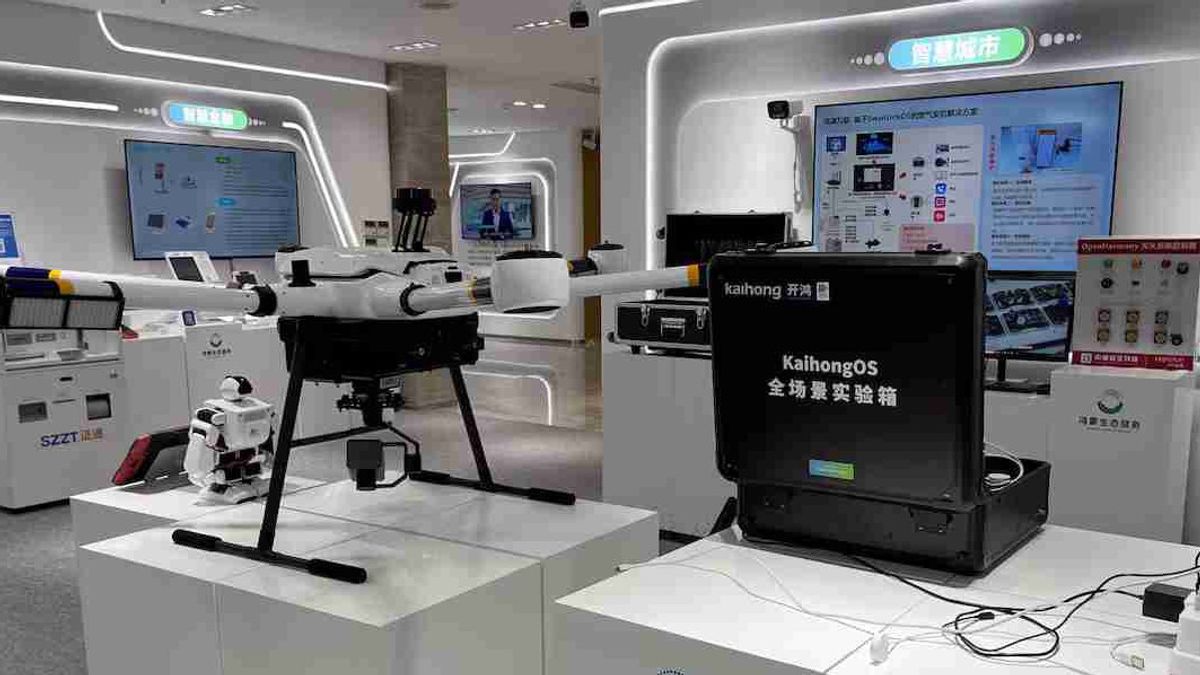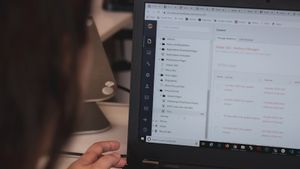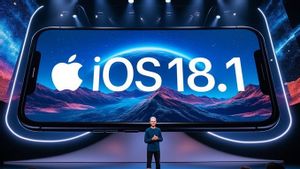JAKARTA - In a small room, drones, bipedal robots, supermarket cashiers, and other devices, it shows China's vision of the future software - where the operating system developed by the national company Huawei has replaced Windows and Android.
The collection is exhibited at the Harmony Ecosystem Innovation Center in the city of Shenzhen, a local government-owned entity that prompted authorities, companies and hardware makers to develop software using OpenHarmony, an open-source version of the operating system that Huawei launched five years ago after US sanctions cut support for Android from Google.
While the recent launch of strong Huawei smartphones has been closely monitored for signs of progress in China's chip supply chain, the company is also quietly building expertise in critical sectors for Beijing's technology self-sufficiency vision, from operating systems to vehicle software.
Chinese President Xi Jinping last year told the Communist Party's elite politburo that China should fight hard to localize other operating systems and technologies "as quickly as possible" as the US tightens exports of advanced chips and other components.
OpenHarmony is now widely promoted in China as a "national operating system" amid concerns that other big companies could be cut off Windows and Android products from Microsoft that many systems rely on.
"This strategic move is likely to erode the market share of Western operating systems such as Android and Windows in China, as local products are increasingly in demand," said Sunny Cheung, an associate at the Jamestown Foundation, a US defense policy group.
In the first quarter of 2024, Huawei's HarmonyOS, an internal version of the operating system, surpassed iOS from Apple to the second best-selling mobile operating system in China after Android, according to research firm Counterpoint. The system has not been launched on smartphones outside China.
Huawei is no longer in control of OpenHarmony, after giving its source code to a nonprofit called the OpenAtom Foundation in 2020 and 2021, according to internal memos and other releases.
But both innovation centers and government documents often refer to OpenHarmony and HarmonyOS alternately as part of a wider Harmony ecosystem. HarmonyOS growth, which is expected to launch in this year's PC version or next year, will encourage OpenHarmony adoption, analysts say.
"Harmony has created a strong basic operating system for the future of Chinese devices," said Richard Yu, chairman of Huawei's consumer business group, at the opening of a developer conference last week.
Huawei first introduced Harmony in August 2019, three months after Washington imposed trade restrictions due to alleged security concerns. Huawei denies its equipment poses a risk.
Since then, China has stepped up self-sufficiency efforts, deciding from the center to share Github's main code and supporting the local version, Gitee.
China banned the use of Windows on government computers in 2014 and now uses most Linux-based operating systems. Microsoft only generates about 1.5% of its revenue from China, its president said this month.
Originally built on the open-source Android system, this year Huawei launched the first "pure" version of HarmonyOS that no longer supports Android-based apps, in a step that further separates the Chinese app ecosystem from the outside world.
A report from the Jamestown Foundation last month said the owner of OpenHarmony, OpenAtom, appears to be coordinating efforts among Chinese companies to develop viable alternatives to US technology, including for defense applications such as satellites. Beijing-based OpenAtom did not respond to requests for comment.
OpenHarmony is the open-source operating system that grew the fastest for smart devices last year, with more than 70 organizations contributing and more than 460 hardware and software products built in various sectors such as finance, education, aerospace, and industry, Huawei said in its 2023 annual report.
"The goal of making it open-source is to replicate Android's success in eliminating license fees for users and giving companies an customizable basis for their own products," said Charlie Cheng, deputy manager of the Harmony Ecosystem Innovation Center, as Reuters visited.
"Harmony will definitely grow into a mainstream operating system, and will give the world a new choice besides iOS and Android," Cheng said. "China is learning from the West."
Google, Apple, and Microsoft did not respond to requests for comment.
The Harmony Ecosystem has received strong support from Huawei's home city, Shenzhen, a city that has historically been used as a test site for policies that were later adopted across China.
SEE ALSO:
In addition to the Harmony center opened in the southwestern city of Chengdu, another 10 centers are expected to open in 10 other cities, according to Shenzhen's central presentation.
The main developer OpenHarmony includes Shenzhen Kaihong Digital, led by Wang Chenglu, a former Huawei employee known as the Harmony "godfather", and Chinasoft. Both have worked on infrastructure software, at Tianjin Port and for mines in China's largest coal-producing province, Shaanxi.
While OpenHarmony is mostly limited in China, Brussels-based open-source group Eclipse Foundation, said it is using it to develop a system called Oniro for use on phones and internet-of-things devices.
China's previous efforts to build large open-source projects have struggled to gain traction among developers, but Huawei's growing smartphone market share and extra work to develop a wider ecosystem provides benefits to Harmony, analysts say.
More than 900 million devices, including smartphones, watches, and car systems, are running on HarmonyOS, while 2.4 million developers are encoded in the ecosystem, Huawei said this month.
"OpenHarmony will need more time and iteration so that these developers are more confident in working with OpenHarmony," said Emma Xu, an analyst with research firm Canalys. "But the reputation, behavior and trust that HarmonyOS has achieved will definitely have a positive impact."
The English, Chinese, Japanese, Arabic, and French versions are automatically generated by the AI. So there may still be inaccuracies in translating, please always see Indonesian as our main language. (system supported by DigitalSiber.id)


















